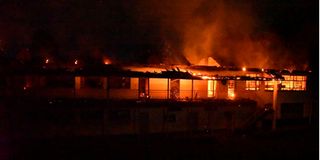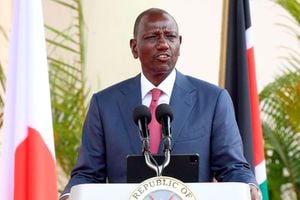
A building at Moi Girls High School Eldoret which hosts laboratories going up in flames on the night of May 19, 2022. No one was injured in the incident.
The failure to implement and enforce safety guidelines in schools is largely to blame for many tragedies like the unfortunate dormitory fire at Hillside Endarasha Academy that caused the death of 17 children, with 14 others injured, on Thursday night.
A number of stakeholders in the education sector who spoke to the Saturday Nation said that despite many investigations, reports, guidelines and policies on safety in schools, families have continued to lose children in tragic incidents.
The deaths of 17 learners at Hillside Endarasha Academy in Nyeri County are only the latest in the long list of other tragedies.
A 2016 report of a special investigation into school unrest chaired by Clare Omolo paints a poor picture of the implementation of guidelines and reports by the government.
“It was found that of the 168 recommendations in the Wangai Report, 65 were fully implemented, 67 partially implemented, 33 not implemented, and three were under implementation. In the Koech Report, of the 122 recommendations, 30 were fully implemented, 45 partially implemented, 38 not implemented and nine were under implementation,” it reads.
The report adds: “It was also found that enforcement of government policies had been weak and supervision not done as expected. There was a clear disregard for policies.”
Also Read: The spectacle of rogue high school students
The Safety Standards Manual for Schools 2008 is a comprehensive document that is clear on what schools need to do to keep children safe. The manual is clear on things like the recommended size of classrooms and their capacity, as well as the design of other school buildings like dormitories.
Each bloc in a school should be fitted with serviced fire extinguishers and placed at each exit with fire alarms fitted at easily accessible points.
Schools are also expected to schedule practice drill sessions for fire, earthquake, lockdown, shelter-in-place and other situations that the safety committee may determine necessary to practice.
However, non-compliance by management of schools and lack of regular inspection by the government has been highlighted as a weak point in ensuring the safety of learners.
“The government should spend more resources on the Quality Assurance and Standards Directorate to enhance inspection and compliance in schools.
"The time has come for Kenyans to rethink the place of boarding schools in this country. Do we really need boarding schools?” said Akelo Misori, the secretary-general of the Kenya Union of Post-Primary Education Teachers (Kuppet).
The chairperson of the Kenya Primary Schools Heads Association, Johnson Nzioka, said some schools, especially the private ones, do not adhere to the guidelines issued by the Ministry of Education.
Escape routes
“Why couldn’t they escape? Was there an escape route? How was that dormitory constructed? Was there a matron? The buck stops with the Quality Assurance and Standards Directorate, but my strong view is that we shouldn’t have boarding in primary school.
"Those children need their parents closer to them more than their teachers. We should care about the welfare of the children,” he said.
The chair of the Kenya Private Schools Association Charles Ochomo confirmed to the Saturday Nation that Hillside Endarasha Academy is a registered member of the association.
“It’s so sad we have such a tragedy. There’s a team on the ground and I’ll be there tomorrow to see how best we can help. We ensure our members comply before we bring them on board. The MoE (Ministry of Education) inspects private schools just as they inspect public ones. We’re private schools, but we teach public children,” he said.
He added: “The investigations are going on, so I wouldn’t like to speculate, but the school was compliant. I’m not an investigator, but looking at the number of deaths, it may have been because of commotion.”
A 2020 audit of school fire preparedness by the Office of the Auditor-General found that many schools are ill-prepared to deal with fire emergencies.
“Implementation of fire safety measures put in place by the MoE has faced a number of challenges such as inadequate infrastructure and limited training in fire safety preparedness,” the report reads.
In 2021, Principal Secretary for Basic Education Belio Kipsang issued a circular to boarding secondary schools on the safety and security of learners. He instructed that more teachers on duty and security be deployed around the dormitories and tuition facilities when students are away from the areas. He also instructed schools to enhance guidance and counselling as some cases of fire and destruction to property have been due to indiscipline among learners.
The chairperson of the Kenya Secondary Schools Heads Association, Willy Kuria, said that full implementation of guidelines may be hindered by a number of factors and there should be constant capacity building for both learners and teachers.
“At times people aren’t sensitive to the issues like fire because they have never happened in their schools and they lose focus on them because they don’t occur every day. Sometimes, the equipment is there but not serviced or is outdated or there’s a lack of personnel. Overall, money is an issue in ensuring safety,” he told the Saturday Nation.
In 2016, a report of a special investigation into school unrest chaired by Ms Omolo also highlighted the safety measures schools should implement to prevent loss of lives.
The team was appointed by former Education Cabinet Secretary Fred Matiang’i after 483 incidents of unrest in schools were reported. These included 239 cases of fire and 244 other forms of unrest.
“The unrest was characterised by the burning of school buildings, especially dormitories, administration blocks, classrooms and food stores. Out of the 282 buildings burnt, 228 were dormitories,” the report reads.
According to the Safety Standards Manual for Schools, all schools should have a safety committee to handle fire safety, among other issues.
“These issues include acquisition and installation of appropriate fire safety preparedness equipment and tools, construction of school buildings as per the required standards and training of the school fraternity on fire safety preparedness.
Fire drills are required once a month as well as drills for other tragedies. Emergency kits in schools should have a first aid kit, whistles, fire blankets, flash torches, fire extinguishers and blueprints of school buildings.
Other precautions recommended include regular checks of the electrical wiring by an electrician and replacement of any that is weak, broken or worn out. The use of hurricane lamps in the dormitories should be properly regulated.
Additionally, schools should invite the local fire department to give talks and demonstrations to learners about fire prevention in a school context.









